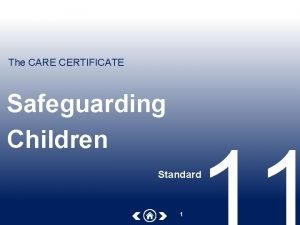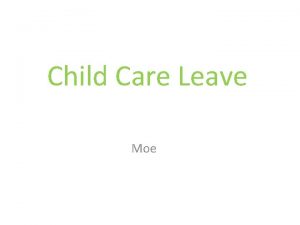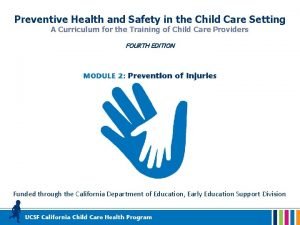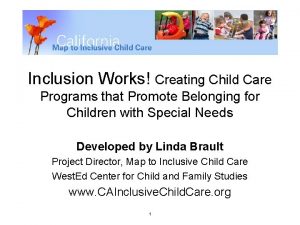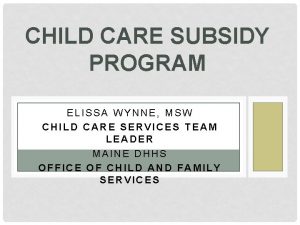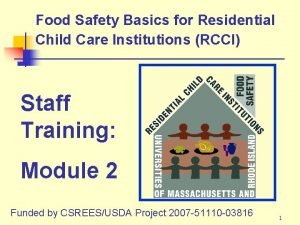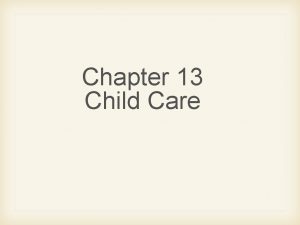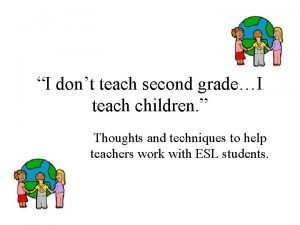HOW TO TEACH CHILDREN WHY TEACH Child care


































- Slides: 34

HOW TO TEACH CHILDREN

WHY TEACH? • Child care = least paid, least respected. Don't choose this work -be chosen. • Your life purpose needs to run through your veins and you need to know this is the purpose for your life.

WHY TEACH? • Because you like it. • It is fun. • To make a difference in children's lives, to see progress. • To help a child grow in self esteem and make good experiences happen.

WHY TEACH? You can enrich lives of families you serve: *Help them with their parenting skills. *Feeling at ease about their children while at work. *Help the child feel unity between school and home

WHY TEACH? • You like diversity • Never boring • You like to feel needed. * The children need you and worship you • There will always be a job for you - high demand.

WHY TEACH? • It is a challenge • There is a lot to learn

What qualities do you need?

What qualities do you need? • • • Must be flexible Sense of humor Energy Patience Character Maturity in order to guide the children

Why not teach? • Not regarded highly • Low pay unless you own a business but limited • Long hours • Crowded, noisy, menial duties

Training needed: • Teaching Assistant (minimum wage) - little if any training. • Teacher - 2 year degree in Early Childhood Education. or CDA • Master Teacher or director - Bachelors degree - can teach K-3 ($24, 000 beginning salary)

Training needed continued: • Specialist - Administrator, curriculum design, parent educator, resource specialist, mental health worker, community college instructor, public policy advocate. • Work mainly with adults, must have masters degree & experience.

Challenge: • Increased need for preschool and after school programs. 75% of mothers with children under 3 years work. • Confront the problem of low wages and benefits. – Parents get what they pay for (low fees = low wages) • Government & industry help needed.

Challenges cont’d: • Educate the public on benefits of quality care. • Improve quality of programs. • Licensing and accreditation – Low standards for Utah • Resist pressure to push children. – Children who are introduced to flash cards, work paper and reading by 3 learn to hate school. There is a lot of parent pressure to push children.

WHO REALLY WINS? • WINNERS: Those who stick with it longer (a lifetime of excellence in experience, ability and knowledge with an enthusiasm to continue learning), not those who get there first (earliest and fastest)

FOR ANYONE WHO LOVES CHILDREN: • It is your ethical responsibility to stand up for what is best for young children. Make children a national priority. You can't speak for your self. The power lies with administrator and legislators. Join together, persists and remain advocates for children your whole life.

• • • What should you teach a 3 year old? colors Shapes Matching Categorizing Seriating Self help - dressing

What should you teach a 4 year old? • • • ABC‘s Numbers Address Phone # Write name

PREREADING SKILLS: • • • Matching Sorting, classification, categorization Sequencing Patterning Seriating - small to large Teaching these skills instead of reading is DAP. All reach the same level of reading by Grade 2.

1915 Rules for Teachers: 1. 2. 3. 4. 5. 6. 7. 8. 9. 10. 11. 12. You will not marry during the term of your contract. You are not to keep company with men. You must be home between the hours of 8 p. m. and 6 a. m. You may not loiter downtown in ice cream stores. You may not travel beyond the city limits unless you have the permission of the chairman of the board. You may not ride in a carriage or automobile. with any man unless he is your father or brother. You may not smoke cigarettes. You may not dress in bright colors. You may under no circumstances dye your hair. You must wear at least two petticoats. Your dresses must not be any shorter than two inches above the ankle. To keep the school room neat and clean, you must: sweep the floor at least once daily, scrub the floor at least once a week with hot soapy water, clean the blackboards at least once a day and start the fire at 7 a. m. so the room will be warm by 8 a. m.

GUIDELINES FOR TEACHING: 1. Make it fun. If your not fun, you're doing something wrong & learning isn't happening. – Never drill, get angry & cold. – Teach excitement and enthusiasm for learning.

GUIDELINES FOR TEACHING: 2. Learning should be a walk of discovery, not a race to the finish line. It should be a shared experience instead of teaching where something must be done by the teacher. Experience it together, child has much to offer.

GUIDELINES FOR TEACHING: 3. Child must be actively involved to learn. The object is not the story but the child's response to it that counts.

GUIDELINES FOR TEACHING: 4. Be sure the message of love get through. Be loving.

GUIDELINES FOR TEACHING: 5. Risk looking silly, loosing perfect discipline, and showing emotion. 6. Eye to eye contact. Sit so this can happen.

GUIDELINES FOR TEACHING: 7. Attention span: 5 to 10 min. on one thing. Change often. 8. Reward accomplishments - treasure box and certificates

THE LEARNING CONE By William Glasser

Tell me…. I forget Show me…. I remember Involve me…. I understand

HOW TO HELP A CHILD DISCOVER FOR THEMSELVES: • Learning is not something we do to the child, it comes from within. • A good learner: – loves learning – eager discoverer – wants to know

HOW TO HELP A CHILD DISCOVER FOR THEMSELVES: • Know child inside and out. • Focus on what the child is feeling. -Avoid putting adult ideas into children's heads.

HOW TO HELP A CHILD DISCOVER FOR THEMSELVES: Be a skillful observer: • What most attracts the child's attention? • What action schemes is the child repeating? • What consequences is the child producing with his actions? • What does the child say as he explores and who is it directed at? • How does he cope with momentary distractions? • Does he integrate the actions of others into his own play?

HOW TO HELP A CHILD DISCOVER FOR THEMSELVES: • Listen carefully to questions asked by the child. It contains an assumption about the world held by the child & gives the teacher ideas for learning encounter. • Play with the child and imitate, thus the child will imitate you.

HOW TO HELP A CHILD DISCOVER FOR THEMSELVES: • Present novel variations on theme. • Change the play to expand it, unobtrusively introduce new ways of doing things. • Be a source of challenge and exploration.

What the Educator Does: • ENGAGE: Create interest & curiosity Teacher • EXPLORE: Encourage learner to work, act as a consultant. Student • EXPLAIN: Learners explain and justify learning. Student • ELABORATE: Apply & expand to alternate explanations. Student • EVALUATE: Observe and assess learners and learners can assess their own learning. In each category, who is doing most of the work? Teacher

 Hey hey bye bye
Hey hey bye bye Primary secondary and tertiary health care
Primary secondary and tertiary health care Dont ask
Dont ask Lds parables
Lds parables If i could only teach you one thing
If i could only teach you one thing 이진트리 복사 순회
이진트리 복사 순회 Safeguarding children care certificate
Safeguarding children care certificate Nj children's system of care
Nj children's system of care Juvenile act
Juvenile act [email protected]
[email protected] Nursing care of hospitalized child
Nursing care of hospitalized child Concept of pediatric nursing
Concept of pediatric nursing Introduction modern concept of child care
Introduction modern concept of child care Hospital environment for sick child ppt
Hospital environment for sick child ppt Hbyc training
Hbyc training Utah department of health child care licensing
Utah department of health child care licensing Child care facility rules and regulations
Child care facility rules and regulations Rights and responsibilities of a child at school
Rights and responsibilities of a child at school Nursing care of hospitalized child
Nursing care of hospitalized child Cn labels for child care
Cn labels for child care Child care moe
Child care moe Child care resource center
Child care resource center Preventive health and safety in the child care setting
Preventive health and safety in the child care setting Manitoba child care association
Manitoba child care association Trilemma of child care
Trilemma of child care Dshs working connections
Dshs working connections Wv dhhr child care assistance
Wv dhhr child care assistance Georgia child care licensing regulations
Georgia child care licensing regulations Section 47 report
Section 47 report Inclusion works creating child care programs
Inclusion works creating child care programs Ga form 3231 blank
Ga form 3231 blank Maine child care subsidy program
Maine child care subsidy program Head start program pros and cons
Head start program pros and cons Child care and protection act 3 of 2015
Child care and protection act 3 of 2015 Residential child care institutions
Residential child care institutions






